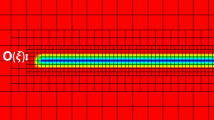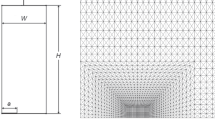Abstract
A mixed formulation is developed and numerically validated for the general 2D anti-plane shear problem in micro-structured solids governed by dipolar strain gradient elasticity. The current mixed formulation employs the form II statement of the gradient elasticity theory and uses the double stress components and the displacement field as main variables. High order, C 0-continuous, conforming basis functions are employed in the finite element approximations (p-version). The results for the mode III crack problem reveal that, with proper mesh refinement at the areas of high solution gradients, the current approximation method captures the exact solution behaviour at different length scales, which depend on the size of material micro-structure. The latter is of vital importance because, near the crack tip, the nature of the exact solution, changes radically as we proceed from the macro- to micro-scale.
Similar content being viewed by others
References
Amanatidou E, Aravas N (2002) Mixed finite element formulations of strain-gradient elasticity problems. Comput Methods Appl Mech Eng 191: 1723–1751
Bathe KJ (2001) The inf–sup condition and its evaluation for mixed finite element method. Comput Struct 79: 243–252
Bhattacharyya PK, Nataraj N (2002) Error estimates for isoparametric mixed finite element solution of 4th order elliptic problems with variable coefficients. Comput Mech 28: 435–455
Bleustein JL (1967) A note on the boundary conditions of Toupin’s strain-gradient theory. Int J Solids Struct 3: 1053–1057
Braess D (1997) Finite elements. Cambridge University Press, UK
Brezzi F, Bathe KJ (1990) A discourse on the stability conditions for mixed finite element formulations. Comput Methods Appl Mech Eng 82: 27–57
Georgiadis HG (2003) The mode III crack problem in microstructured solids governed by dipolar gradient elasticity: Static and dynamic anlaysis. J Appl Mech 70: 517–530
Giannakopoulos AE, Stamoulis K (2007) Structural analysis of gradient elastic components. Int J Solids Struct 44: 3440–3451
Gourgiotis PA, Georgiadis HG (2007) Distributed dislocation approach for cracks in couple-stress elasticity: shear modes. Int J Fract 147: 83–102
Karlis GF, Tsinopoulos SV, Polyzos D, Beskos DE (2007) Boundary element analysis of mode I and mixed mode (I and II) crack problems of 2-D gradient elasticity. Comput Methods Appl Mech Eng 196: 5092–5103
Lam DCC, Yanga F, Chonga ACM, Wanga J, Tong P (2003) Experiments and theory in strain gradient elasticity. J Mech Phys Solids 51: 1477–1508
Markolefas S, Tsouvalas DA, Tsamasphyros GI (2008) Some C°-continuous mixed formulations for general dipolar linear gradient elasticity boundary value problems and the associated energy theorems. Int J Solids Struct 45: 3255–3281
Markolefas SI, Tsouvalas DA, Tsamasphyros GI (2007) Theoretical analysis of a class of mixed, C 0 continuity formulations for general dipolar gradient elasticity boundary value problems. Int J Solids Struct 44: 546–572
Mindlin RD (1964) Micro-structure in linear elasticity. Arch Rat Mech Anal 16: 51–78
Mindlin RD, Eshel NN (1968) On first-gradient theories in linear elasticity. Int J Solids Struct 4: 109–124
Polyzos D, Tsepoura KG, Tsinopoulos SV, Beskos DE (2003) A boundary element method for solving 2-D and 3-D static gradient elastic problems. Part I. Integral formulation. Comput Methods Appl Mech Eng 192: 2845–2873
Szabo B, Babuška I (1991) Finite element analysis. Wiley, New York
Tsamasphyros GI, Markolefas S, Tsouvalas DA (2007) Convergence and performance of the h- and p-extensions with mixed finite element C 0-continuity formulations, for tension and buckling of a gradient elastic beam. Int J Solids Struct 44: 5056–5074
Zhang L, Huang Y, Chen JY, Hwang KC (1998) The mode III full-field solution in elastic materials with strain gradient effects. Int J Fract 92: 325–348
Author information
Authors and Affiliations
Corresponding author
Rights and permissions
About this article
Cite this article
Markolefas, S.I., Tsouvalas, D.A. & Tsamasphyros, G.I. Mixed finite element formulation for the general anti-plane shear problem, including mode III crack computations, in the framework of dipolar linear gradient elasticity. Comput Mech 43, 715–730 (2009). https://doi.org/10.1007/s00466-008-0340-9
Received:
Accepted:
Published:
Issue Date:
DOI: https://doi.org/10.1007/s00466-008-0340-9




